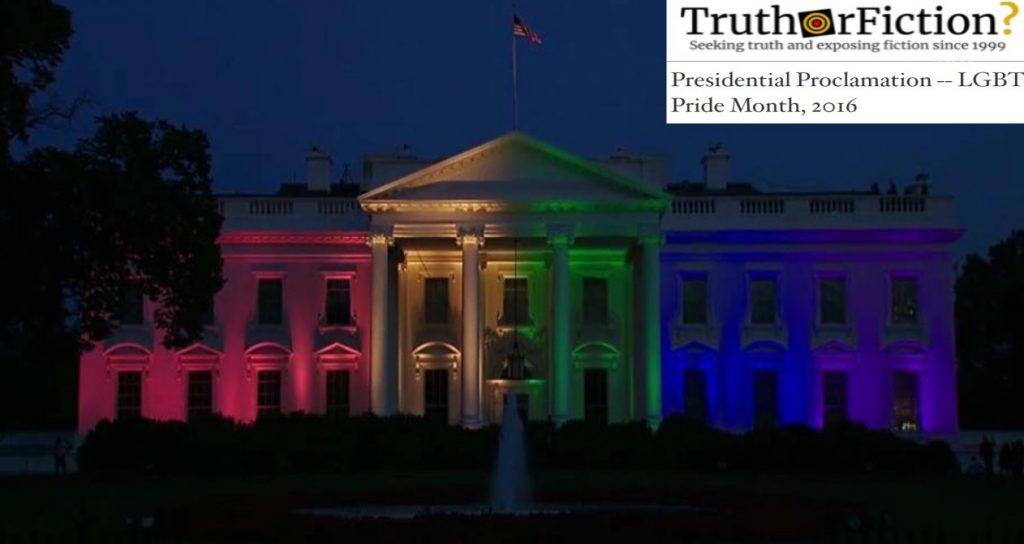In June 2016 we reported that then-President Barack Obama had released a proclamation declaring it to be LGBT Pride Month.
At the time, Obama reflected on the June 2015 Supreme Court decision in Obergefell v. Hodges, which legalized same-sex marriage across the U.S.
Last year’s landmark Supreme Court decision guaranteeing marriage equality in all 50 States was a historic victory for LGBT Americans, ensuring dignity for same-sex couples and greater equality across State lines. For every partnership that was not previously recognized under the law and for every American who was denied their basic civil rights, this monumental ruling instilled newfound hope, affirming the belief that we are all more free when we are treated as equals.
While we also noted that Obama had done the same a year earlier, prior to the high court’s decision we did not include additional context.
Even if it became popular in right-wing circles to cast Obama’s presidency as a singular tipping point for “liberal” America, he was not the first president to recognize Pride month; Bill Clinton did so in 1999 and 2000, the final two years of his eight-year term in office.
Clinton’s successor, George W. Bush, did not continue the practice during his own eight years in the presidency.
Obama, however, reinstated the Pride proclamations upon taking office in 2009 through the end of his two terms in office. The Washington Post reported in June 2017 that Donald Trump, who took office after Obama, did not follow suit despite claiming his administration would be LGBTQ-friendly in campaign rallies:
“Believe me, I am better for the gay community,” Trump said, contrasting himself with Hillary Clinton.
The gay community didn’t agree. Trump won 14 percent of the LGBT vote, according to exit polling, compared with Clinton’s 77 percent. He won 80 percent of the evangelical vote.
As NBC News reported in 2019, Trump reversed course that year and issued his own Pride proclamation, though it characteristically ignored his own record:
Trump pointed to his administration’s efforts to decriminalize homosexuality worldwide that are being led by the U.S. Ambassador to Germany, Richard Grenell, who is gay. But when Trump was asked about that effort shortly after its roll out in February, he said, “I don’t know.”
Trump’s recognition of Pride Month — he’s the first Republican president to do so after President Bill Clinton established Pride Month in 1999, since President George W. Bush never recognized it during his time in office — comes amid a flurry of anti-LGBTQ activity in the past few months. Trump rolled back healthcare rules aimed at helping LGBTQ people and also opposed the passage of the Equality Act.
Trump did not issue a proclamation recognizing Pride month in 2020.
After defeating Trump in that year’s presidential election, President Joe Biden renewed the practice, issuing Pride month proclamations — now expanded to include Bisexual, Transgender, and Queer Americans — in both 2021 and 2022.
Biden also signed an executive order his administration said would fight discriminatory state laws targeting LGBTQ communities, by banning the use of federal funding from any program that employs discredited “conversion therapy.”
The order will also direct federal agencies like the Department of Health and Human Services, Department of Education, and Department of Housing and Urban Development to launch new efforts to fight ongoing problems affecting LGBTQ Americans like homelessness and lack of educational support.
Update 6/16/2022, 12:56 a.m. PST: This article has been revamped and updated. You can review the original here. — ag
- Presidential Proclamation -- LGBT Pride Month, 2016
- Presidential Proclamation-- LGBT Pride Month, 2015
- Supreme Court Declares Same-Sex Marriage Legal In All 50 States
- Proclamation 7203—Gay and Lesbian Pride Month, 1999
- Gay and Lesbian Pride Month, 2000
- Proclamations Issued by President Bush
- Presidential Proclamation - LGBT Pride Month
- Last Year, June Was National Pride Month. This Year, It Isn't.
- Trump Recognizes LGBTQ Pride Month for First Time
- A Proclamation on Lesbian, Gay, Bisexual, Transgender, and Queer Pride Month, 2021
- A Proclamation on Lesbian, Gay, Bisexual, Transgender, Queer, And Intersex Pride Month, 2022
- President Biden to Sign Historic Executive Order Advancing LGBTQI+ Equality During Pride Month

